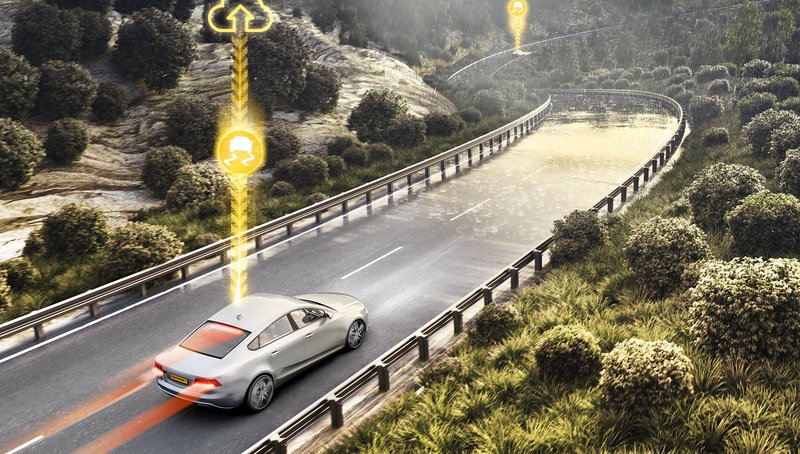Continental’s eHorizon and PreviewESC Systems Increase Safety Through Predictive Technology
- eHorizon anticipates the route and road conditions ahead and interacts with the control system
- PreviewESC is an additional advancement towards achieving Vision Zero
AUBURN HILLS, Mich., July 31, 2019 - Unpredictable road conditions present both a challenge and a safety risk for drivers. Technology company Continental has developed a function that uses matched sensors, data processing and assistance systems to tell the vehicle exactly how fast to travel as it anticipates what to expect from the bends and road surface conditions ahead. Continental is now networking several established technologies to achieve a new level of safety on the way to Vision Zero, the vision of zero traffic crashes.
Continental eHorizon functions as an anticipatory, virtual sensor
The Road Condition Observer uses the systems already present in the vehicle, such as the Electronic Stability Control (ESC) and camera systems, to classify the road conditions as dry, wet, risk of hydroplaning, snow-covered or icy. Once the system identifies the road condition, it uses an estimated coefficient of friction to predict how well the tires will grip the respective section of road. The Road Condition Observer continuously transmits the coefficient of friction data in real-time to the Continental.cloud, where information from other vehicles and weather data, such as temperature and precipitation, is also collected.
“The Road Condition Observer successfully combines swarm, weather data, and information on road surface conditions to provide accurate predictions,” said Tamara Snow, Director of Interior Systems and Technology, Continental North America. “The ability to alert other vehicles of an upcoming hazard is particularly beneficial for fleets, improving safety on the road and minimizing preventable repair costs.”
In the cloud, eHorizon processes the data collected from the entire vehicle fleet with the help of artificial intelligence and other technologies. Continental uses artificial intelligence to create models which can detect road objects and predict hazardous situations. These models can react to changing conditions and use input and output data to adjust functions through learning tasks. Additionally, neural networks are used for image processing and object detection.
eHorizon is already available in commercial vehicles, supporting truck drivers in achieving better fuel economy and enabling automated driving functions. As soon as it is possible to use the data from the Road Condition Observer to create dynamic coefficient of friction maps, eHorizon will include this information in its calculations for greater road safety and comfort. eHorizon knows the road ahead - not only its static properties (curve radii, gradients, slopes), but also the current road conditions.
PreviewESC adapts the vehicle speed to the real-time situation
This information from eHorizon is fundamental for PreviewESC, an additional ESC function developed by Continental. When eHorizon shares the data regarding the coefficient of friction and curve radius of the road ahead, PreviewESC compares this with the actual vehicle speed. The system can, for example, determine whether the vehicle is traveling too fast to make it safely around the next bend.
“Once it is determined that action is necessary, PreviewESC can either warn the driver or, if necessary, automatically adjust the vehicle speed,” said Jeremy McClain, Director of Chassis and Safety Systems and Technology, Continental North America. “This situation-specific, anticipatory function represents yet another step on the road toward Vision Zero, but it will also be a requirement for automated and autonomous driving.”
To select the optimal driving strategy in all conditions, cars need to know the route ahead and the amount of available grip on the road. If the bend is wet or icy, for instance, such a braking intervention will happen earlier than under dry road conditions. With anticipatory speed adjustment, eHorizon can lower the likelihood of an emergency maneuver.
eHorizon enables a variety of new functions
In addition to PreviewESC, eHorizon will enable more new functions in the future. The system could regulate the timing of emergency braking depending on the road’s coefficient of friction. It can also accurately predict the tail end of a traffic jam that is not yet visible from the vehicle. eHorizon is one building block of Vehicle-to-X (V2X) communication and supports Vehicle-to-Vehicle communication in providing better coverage and full functionality to enhance safety. With systems expertise ranging from sensor technology and data processing, right through to their implementation in driving functions, these technologies are ready and available at Continental.
Continental develops pioneering technologies and services for sustainable and connected mobility of people and their goods. Founded in 1871, the technology company offers safe, efficient, intelligent, and affordable solutions for vehicles, machines, traffic and transportation. In 2018, Continental generated sales of €44.4 billion and currently employs around 245,000 people in 60 countries and markets.

Mary Arraf
Head of Communications Automotive and Continental North America

